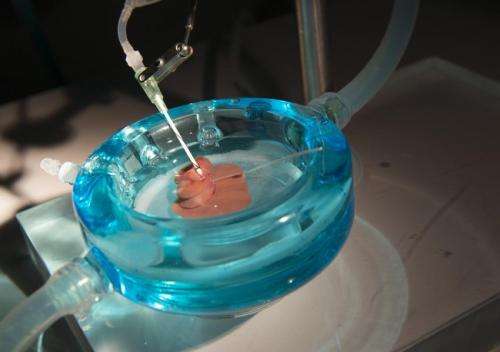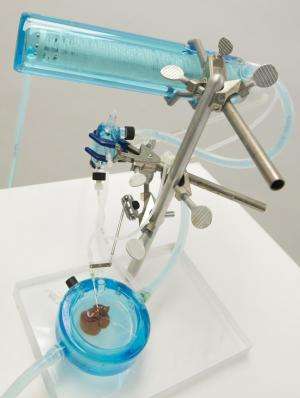Researchers extend liver preservation for transplantation

Researchers have developed a new supercooling technique to increase the amount of time human organs could remain viable outside the body. This study was conducted in rats, and if it succeeds in humans, it would enable a world-wide allocation of donor organs, saving more lives.
The research is supported by National Institute of Biomedical Imaging and Bioengineering (NIBIB) and the National Institute of Diabetes and Digestive and Kidney Disease (NIDDK), both parts of the National Institutes of Health.
The first human whole organ transplant 60 years ago—a living kidney transplant—changed the landscape of the medical world. Since then, transplants of skin, kidneys, hearts, lungs, corneas, and livers have become commonplace but due to a shortage of donor organs, more than 120,000 patients are still on waitlists for organ transplantation in the United States alone.
Current technology can preserve livers outside the body for a maximum of 24 hours using a combination of cold temperatures and a chemical solution developed by scientists at the University of Wisconsin-Madison in 1983. The solution helps keep the liver tissue from dying while in transit to the recipient site. This has helped increase the number of successful liver transplants—but extending even further the time a liver can survive outside the body would provide many benefits. It would allow for more time to prepare the patient and ease logistics at the donor hospital site, reduce the urgency of rushing the organ to its destination, and expand the donation area to allow for transcontinental and intercontinental transplantations—thus increasing the chances of patients finding better matches while simultaneously significantly reducing costs.
The difficulty with long-term preservation of human organs stems mostly from the extensive tissue damage that occurs when organs are cryopreserved, frozen at temperatures of -320.8 degrees Fahrenheit. While successful for single cells and simple tissues, the problem is exacerbated with whole organs because of the multiple cell types and other structures that react differently to cold. To combat these problems, Martin Yarmush, M.D., Ph.D., and Korkut Uygun, Ph.D., investigators in the Center for Engineering in Medicine at Massachusetts General Hospital (MGH), Boston, have developed a four-step preservation technique that has tripled the amount of time that rat livers can be stored before transplantation.

In the June 29 online issue of Nature Medicine, the researchers describe their process. The first step is to employ the use of machine perfusion—a way of delivering oxygen and nutrients to capillaries in biological tissues while outside the body—to supercool the liver tissue without causing irreversible damage to the cells. In order to accomplish this, the MGH team added 3-OMG (3-O-methyl-D-glucose), a non-toxic, modified glucose compound, to the solution being delivered to the liver. The 3-OMG is taken up and because it cannot be metabolized by cells, accumulates in the hepatocytes (liver cells), acting as a protectant against the cold. The team also modified the solution by adding PEG-35kD (polyethylene glycol) to specifically protect cell membranes. Ethylene glycol is the active ingredient in anti-freeze, and it works by lowering the freezing point of a solution.
The livers were then slowly cooled below the freezing point, to 21 degrees Fahrenheit, without inducing freezing—thereby supercooling the organ for preservation. After storing the organs for several days, the researchers again used machine perfusion to rewarm the organ, while also delivering oxygen and other nutrients to prepare the organ for transplantation.
Using this new technique, the researchers were able to store the supercooled rat livers for three days (72 hours) and four days (96 hours) at 21 degrees Fahrenheit. All the rats who had supercooled livers stored for three days survived three months, but none of the rats who had transplants using current methods did. The survival rate for animals receiving livers stored for four days was 58 percent. When testing to see if all the steps in their method were essential, the researchers found that if they eliminated the supplemental components PEG-35kD or 3-OMG, none of the rats survived for even a week. If they did not use machine perfusion or supercooling, death occurred within an hour of transplantation.
"The next step will be to conduct similar studies in larger animals," said Rosemarie Hunziker, Ph.D., program director of Tissue Engineering and Regenerative Medicine at NIBIB. "It is exciting to see such an achievement in small animals, by recombining and optimizing existing technology. The main point here is that using all of these approaches at once was what led to success. Halfway measures did not do. Such a tour de force reflects this team's very deep understanding of the complex processes at work here, and how they relate simultaneously to each other."
The process must go through extensive testing and refinement before it could be considered for use in humans. But the technique's achievement in being the first method to have a successful survival rate after the livers had been stored for three days and possible potential for four-day storage has broad implications for the future of liver transplantation.
"The longer we are able to store donated organs, the better the chance the patient will find the best match possible, with both doctors and patients fully prepared for surgery," said Hunziker. "This is a critically important step in advancing the practice of organ storage for transplantation."
More information: Nature Medicine, dx.doi.org/10.1038/nm.3588















